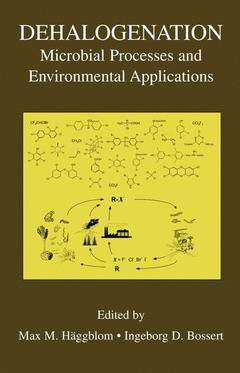Dehalogenation, Softcover reprint of the original 1st ed. 2004 Microbial Processes and Environmental Applications
Langue : Anglais
Coordonnateurs : Häggblom Max M., Bossert Ingeborg D.

Halogenated organic compounds constitute one of the largest groups of environmental chemicals. The industrial production of new halogenated organic compounds has increased throughout the last century peaking in the 1960s, and continuing in widespread use today. Organohalides are integral to a variety of industrial applications, including use as solvents, degreasing agents, biocides, pharmaceuticals, plasticizers, hydraulic and heat transfer fluids, and intermediates for chemical synthesis, to name a few. It is important to recognize the beneficial aspects of halogenated organic compounds, as well as their potentially deleterious impact on the environment and health. Recognition ofthe adverse environmental effects ofmanytypes oforganohalide compounds has led to efforts to reduce or eliminate the most problematic ones. Although organohalide compounds are typically considered to be anthropogenic industrial compounds, they have their counterpart in several thousands of natural biogenic and geogenic organohalides, representing most classes of organic chemicals. Natural sources account for a significant portion of the global organohalogen budget. This volume authored by recognized experts in the field provides a current perspective on how both natural and synthetic organohalides are formed and degraded, and how these processes are incorporated into a global halogen cycle. The focus is on microbial processes, since these play a major role both in the production and degradation, i. e. , cycling of halogenated organic compounds inthe environment. This book is organized into five parts. Part I, Introduction, provides a global perspective on the issues of organohalides and their fate in the environment.
Halogenated Organic Compounds - A Global Perspective.- Microbial Processes.- Microbial Ecology of Dehalogenation.- Diversity of Dechlorinating Bacteria.- Thermodynamic Considerations for Dehalogenation.- Dehalogenation by Anaerobic Bacteria.- Biodegradation of Chlorinated Compounds by White Rot Fungi.- Biochemistry and Chemistry.- Bacterial Growth on Halogenated Aliphatic Hydrocarbons: Genetics and Biochemistry.- Aromatic Dehalogenases: Insights into Structures, Mechanisms, and Evolutionary Origins.- Abiotic Dehalogenation by Metals.- Environmental Fate and Applications.- Bioavailability of Organohalides.- Biotransformation of Halogenated Pesticides.- Biodegradation of Atmospheric Halocarbons.- Dechlorination of Sediment Dioxins: Catalysts, Mechanisms, and Implications for Remedial Strategies and Dioxin Cycling.- Redox Conditions and the Reductive/Oxidativebiodegradation of Chlorinated Ethenes in Groundwater Systems.- Microcosms for Site-Specific Evaluation of Enhanced Biological Reductive Dehalogenation.- Chlorinated Organic Contaminants from Mechanical Wood Processing and Their Bioremediation.- Polychlorinated Biphenyls in Aquatic Sediments: Environmental Fate and Outlook for Biological Treatment.- Summary.- Environmental Dehalogenation — Problems and Recommendations.
Date de parution : 03-2013
Ouvrage de 502 p.
15.5x23.5 cm
Date de parution : 04-2003
Ouvrage de 502 p.
15.5x23.5 cm
Thèmes de Dehalogenation :
Mots-clés :
Biogen; Bioremediation; biochemistry; ecology; microorganism; air pollution and air quality; ecotoxicology
© 2024 LAVOISIER S.A.S.



